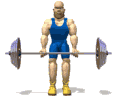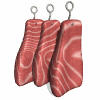PROTEINS




This animation (Audio - Important) describes the structure of amino acids.
Proteins have four kinds of structure called primary, secondary, tertiary and quaternary structure.
Primary structure refers to a chain of amino acids linked together through the formation of peptide bonds . When three or more amino acids are linked together, they are called a polypeptide chain.
This animation (Audio - Important) describes the formation of a polypeptide chain.
Secondary structure occurs when hydrogen bonds join the primary chains of amino acids together. The result is a helical coil or sheetlike array.
Tertiary structure results from the interactions between different areas of the protein to form a three dimensional shape.
Quaternary structure results when two or more polypeptide chains, called subunits, combine to produce large protein structures. Hemoglobin which carries oxygen in the blood is an example of quaternary protein structure.
This animation (Audio - Important) describes the structure of hemoglobin.
REVIEW: Amino acids are the building blocks for�
REVIEW: Amino acids are linked by what kind of bonds to form the primary structure of a protein?�
REVIEW: The secondary structure of proteins can be
a. helical.
b. sheetlike.
c. globular.
d. the sequence of amino acids.
e. both helical and sheetlike.�
PREVIOUS
NEXT
LECTURE 3 INDEX
MAIN INDEX